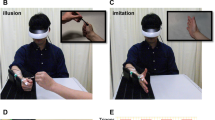Abstract
This study of 40 paraplegics concerns their reactions to their neurological handicap immediately after their trauma. It shows that the body image is not spontaneously modified after the disconnection of the sensory paths. The awareness of the loss of motor function is more rapidly realised and this takes an important part in the subsequent somatognostic representation.
The visual aspect being preserved, the paraplegic's body image generally remains intact. This statement tends to lead to philosophical discussions concerning the body and the mind. However, it is also most important concerning the participation and efforts necessary during the period of rehabilitation.
Similar content being viewed by others
Log in or create a free account to read this content
Gain free access to this article, as well as selected content from this journal and more on nature.com
or
References
NoëL, G & Heilporn, A (1966). Considérations sémiologiques relatives aux paraplégies traumatiques. Acta neurol. belg., 66, 873.
Sivadon, P & Gantheret, F (1965). La rééducation corporelle des fonctions mentales. Les Editions sociales françaises.
Author information
Authors and Affiliations
Rights and permissions
About this article
Cite this article
Heilporn, A., Noel, G. Reflections on the consciousness of disability and somatognosis in cases of acute spinal injuries. Spinal Cord 6, 122–127 (1968). https://doi.org/10.1038/sc.1968.22
Issue date:
DOI: https://doi.org/10.1038/sc.1968.22


